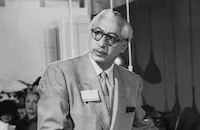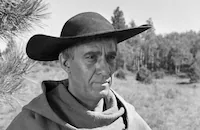The Law vs. Billy the Kid

Brief Synopsis
Cast & Crew
William Castle
Scott Brady
Betta St. John
James Griffith
Alan Hale Jr.
Paul Cavanagh
Film Details
Technical Specs

Synopsis
Drifter Billy Bonney works one full day as a ranchhand, only to have foreman Parsons refuse to pay him full salary simply because he is new. Billy takes the full salary and when he is pursued by Parsons and hand Carl Trumble, he is forced to kill Trumble in self-defense. Fellow worker Pat Garrett is fired for siding with Billy, and the two ride into New Mexico territory to avoid the law. When Billy kills a steer for food, he and Pat are confronted by Bob Ollinger, foreman for John H. Tunstall, a wealthy Englishman who is the victim of continuous assaults by competing cattle baron L. G. Murphy and the corrupt local sheriff, Tom Watkins. Tunstall asks Billy and Pat to work for him to defend his herds against Murphy's vicious tactics, and after Billy meets Tunstall's young niece, Nita Maxwell, he agrees to stay. Over the following weeks, Billy works hard, earning Tunstall's approval. Jealous of Billy and Nita's blossoming relationship, however, Ollinger beats up Billy, claiming he is disrespectful. When Tunstall fires him, Ollinger goes to Murphy and Watkins, revealing that Billy may be a fugitive. Watkins discovers a wanted poster of Billy, and Ollinger insists on his arrest. Murphy encourages Watkins to arrest not only Billy, but Tunstall as well for harboring a fugitive. Watkins then takes a posse out to Tunstall's ranch. Billy hides when he sees their approach, but witnesses Tunstall's murder by a posse member, who assumes that Tunstall is reaching for a gun, instead of his spectacles. Only three of Tunstall's ranchhands, Dave Rudabaugh, Tom O'Folliard and Charlie Bowdre, agree to join Billy in seeking revenge. Billy kills Tunstall's murderer, then returns to the ranch. Nita's father, Pete Maxwell, informs Billy that Pat has agreed to run the ranch, but Pete and Nita are dismayed when Billy enthusiastically relates his revenge and intention to pursue Watkins. Upset over their lack of support, Billy departs and takes up horse thievery with his small gang to survive. After Tunstall's death, Governor Lewis Wallace removes Watkins as sheriff and summons Pat to offer him the post. Wallace explains that he believes Billy might surrender to a friend, then proposes to offer Billy a full pardon, but not to pursue Watkins, who claims the killings under his tenure were legal. When Pat hesitates, Wallace reveals that should Pat refuse the post, he will place Lincoln County under martial law and have Billy shot on sight. Faced with this option, Pat agrees to become sheriff. Soon after, Pat visits Billy, who is surprised, then pleased by Pat's new job, believing Pat will help him catch Watkins legally. Pat informs Billy of the governor's wish to speak with him and Billy grudgingly agrees to meet at the Tunstall ranch when he visits Nita. The next night, Nita pleads with Billy to listen to the governor's proposal, but Billy responds angrily to Wallace's acknowledgment that Watkins will remain free and refuses the offer. Afterward, Billy gives Nita a brooch and tells her that it is part of a set with a ring. Nita suggests that if Billy is serious about a future with her and Wallace's offer, he should bring her the ring. Billy reconsiders and gets the ring, but later runs into Watkins and Ollinger in the saloon. When he tries to leave peaceably, however, Watkins draws and Billy kills him, then beats up Ollinger. Pat rounds up a posse, which Ollinger demands to join, and tracks Billy and his men down to a small cabin. After a shootout in which all the other members of Billy's gang are killed, Pat arrests Billy, who is compliant. Pat stops the posse at the Tunstall ranch, where Ollinger purposely brings the handcuffed Billy to a stunned Nita. She discovers the ring, however, and realizes he intended to give himself up. Nita then agrees to wait for Billy, but he is found guilty and sentenced to hang. Billy's request for help from Wallace is rejected because he refused the governor's initial offer. Ollinger taunts Billy daily at the jail, until Billy tricks the sheriff and escapes. He tracks Ollinger to the local hotel, where he kills him then goes into hiding for several months. Pat pursues Billy to no avail, but eventually Billy returns to Tunstall's to see Nita. Billy tells her he has a small house in Mexico and asks her to run away with him. She agrees, but before she can finish packing, Billy is shot dead by Pat.

Director

William Castle
Cast
Scott Brady

Betta St. John

James Griffith

Alan Hale Jr.

Paul Cavanagh
William "bill" Phillips

Benny Rubin
Steve Darrell
George Berkeley
William Tannen
Richard Cutting
John Cliff
Otis Garth

Martin Garralaga
Frank Sully
William Fawcett
Robert Griffin
Crew
Mischa Bakaleinikoff
Sidney Clifford
Francis Cugat
Jack Erickson
Henry Freulich
Bernard Gordon
Charles S. Gould
Sam Katzman
Herbert Leonard
John Livadary
Paul Palmentola
Aaron Stell
Janet Stevenson
Philip Stevenson

Film Details
Technical Specs

Articles
The Law vs. Billy the Kid
The Law vs. Billy the Kid (1954) is a low-budget quickie produced by Sam Katzman, head of Columbia Pictures' B unit, and directed by William Castle, who for ten years had been turning out B westerns, noirs and adventure films. Castle was still a few years away from the gimmicky horror films like The Tingler (1959) that would make his reputation.
Playing Billy here is Scott Brady, whose birth name was Gerard Tierney and whose brothers -- Edward and the better-known Lawrence -- were also actors. But the most interesting element of this film's making really pertains to its screenwriter, Bernard Gordon, who didn't receive screen credit until 1997.
Gordon had begun his career as a reader in the Paramount story department, and in 1952, he notched his first screenplay credit, for Flesh and Fury. But that same year, he was named as a Communist by a witness in the House Un-American Activities Committee, and he was immediately fired and blacklisted.
Two other films he'd written that were already in production bore his name upon release in 1953 and 1954, but going forward, Gordon was blacklisted, which meant that even if he could find work, he would not receive credit. So like other blacklisted writers, Gordon turned to using "fronts," or names of other people that would mask the true authorship of his scripts. In the case of The Law vs. Billy the Kid, as Gordon later recounted in his memoir Hollywood Exile, he got a call one day from Sam Katzman's assistant, asking for any western stories. The assistant never mentioned the blacklist. Gordon remembered that his friends Janet and Philip Stevenson (also blacklisted) had years earlier written an unproduced play about Billy the Kid, and he got them to allow Gordon to submit a synopsis of the play to Columbia under the name "John T. Williams." The ploy worked, and Gordon (as John T. Williams) was hired to write the screenplay, and he paid the Stevensons one-third of his fee.
John T. Williams in reality was a camera shop salesman in Los Angeles and a friend of Gordon's. Gordon used real people as fronts, he later explained, because they "had genuine social security numbers which could be used without creating further consequences."
Gordon managed to get quite a few scripts produced this way and found better success in Europe, but by and large he was paid little and his career never had the real chance it might have had but for the blacklist. In 1997, the Writers Guild of America restored credits for many blacklisted writers including Gordon, who was the most prolific of the bunch with nearly a dozen affected credits. But Gordon, while appreciative, was still bitter, telling The New York Times, "The action by the guild comes about 40 years too late to help my Hollywood career. I sure am angry at the way I was treated by all the major studios. They blacklisted me, and I couldn't get any work in this damn town.
Upon release in 1954, The Law vs. Billy the Kid received fair notices and some criticism for straying pretty far from the facts. Variety called it "standard fare for the outdoor film market... Billy the Kid, played by Scott Brady, is shown as practically forced to become a killer -- a dubiously sympathetic treatment." The Hollywood Reporter deemed it "better than average" but complained, "Scott Brady...looks more like a college boxing champion than a kid."
Leading lady Betta St. John had been a child actress in the early 1940s but then left Hollywood, finding huge success as "Liat" in the original Broadway staging of South Pacific, which opened in 1949. Following that production, she returned to movies in 1953 with Dream Wife, and continued a film and television career until she retired for good in the early 1960s. As of 2015, she is 85 years old.
This was one of eight pictures directed by William Castle released in 1954. Two others also dealt with famous western outlaws: Masterson of Kansas (1954) and Jesse James vs. the Daltons (1954).
By Jeremy Arnold

The Law vs. Billy the Kid
Quotes
Trivia
Notes
Although John T. Williams was given screen credit for the film's story and screenplay when the picture was initially released, according to information in the file on the film in the MPAA/PCA Collection at the AMPAS Library, John T. Williams was a pseudonym for Bernard Gordon, who was blacklisted by the motion picture industry in 1952. The Law vs. Billy the Kid was his first work after the blacklist. In correspondence with AMPAS, dated 1986, Gordon indicated that the film was based on a play by Janet and Philip Stevenson, who were also blacklisted. According to information in the Santa Fe Community Theater Collection at the Fray Angélico Chavez History Library in Santa Fe, NM, in 1933 the Santa Fe Players presented a theatrical play by Philip Stevenson titled Sure Fire, Episodes in the Life of Billy the Kid. However, it has not been determined if this was the basis for the film's screenplay. In modern interviews, Janet Stevenson and Gordon reported that The Law vs. Billy the Kid was based on an unproduced play by both Janet and Philip Stevenson. According to Gordon, the Stevensons prepared a synopsis of their play, which Gordon submitted as an original story under the joint name John T. Williams. Gordon stipulated that the corrected writing credits should read: Story by Janet and Philip Stevenson; screenplay by Bernard Gordon. According to an October 1997 Hollywood Reporter article, credits on eight films written by Gordon under pseudonyms, including The Law vs. Billy the Kid, were being properly listed by the Writers Guild of America.
The real Billy the Kid was born Henry McCarty (1859-1881) and later changed his name to William H. Bonney. As in the film, Bonney's life of crime was spent predominently in New Mexico; however, the story of Bonney working for an English-born cattleman was based on a legend that several films on the character have perpetuated. As mentioned in the film, Lew Wallace, governor of the New Mexico Territory (1878-1881), was also the author of the well-known novel and later film, Ben-Hur. For more information on the lives of William Bonney and Pat Garrett and the many films about them, please see the entry for M-G-M's 1941 film Billy the Kid and the entry for RKO's 1943 release The Outlaw in AFI Catalog of Feature Films, 1941-50.














